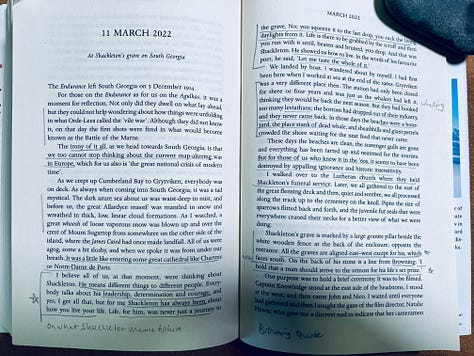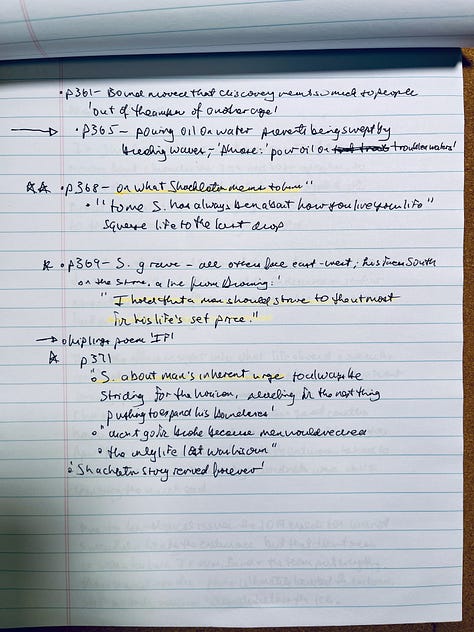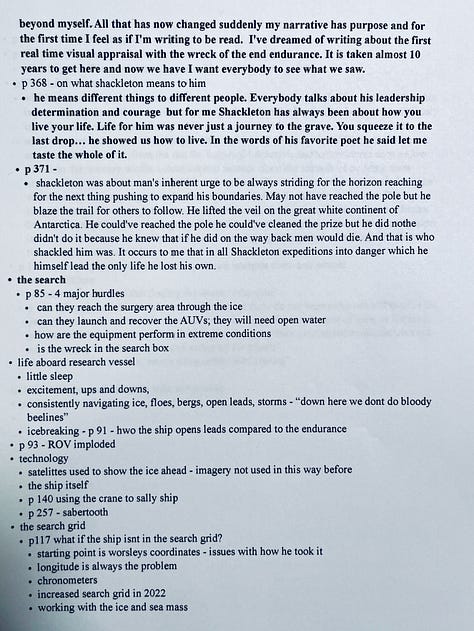A reader recently asked me about my note-taking process. This was a very timely question because I’d just been writing about my note-taking process for my own writing practice.
Often I’ll read a book with the goal of writing an essay or blog post about it, or to use the information I’ve gathered from the book in an essay. Lately I’ve noticed that once I’ve read the book I fail to do the follow-up work of converting what I’ve learned into notes that I can use in my writing.
Over the past two weeks I wrote about two books I read earlier this year on Shackleton’s Endurance story. While I gave myself two months to read the books, I only gave myself two weeks to write the blog posts. During this tight deadline I had to quickly review what I’d learned, take notes on it, and convert it into a blog post. I didn’t have time to try something new. I realized I already have a system of note-taking that I’ve been using for years, but always find myself trying to ‘reinvent the wheel’. I spend too much time wavering on how to take notes (index cards or typed? highlighter or pencil?) instead of following the tried-and-true system (at least for me) I’ve been using since college.
So I learned a big lesson while writing those two blog posts earlier this month: I have a process of note-taking so when it’s time to take notes I should follow this system that’s served me well for many years. No need to wonder if I should do it this way or that way. I’ll just remember to follow this system since it works best for me, I’m familiar with it, and it’s helped me get the results I’m looking for.
My note-taking process is three steps of filtering information from a book, essay, scholarly paper, or other source into notes which I can use in my writing.
Marginalia. First I take notes while reading. This is the most important stage. If I don’t take notes while I’m reading, I’ll probably have to read it again. Everything that follows comes from this first step. How do I do this? I take notes in the margins, I underline or highlight text in the book, and dog-ear pages. I also write notes on an index card or in a notebook. The experience of reading the book and writing about it is a constant, ongoing conversation with myself.
Notes. After I finish reading, I’ll write a few paragraphs about the book, my impressions, and what I’ve learned, just to start putting what I’ve read into my own words. Then I’ll begin the process of converting my marginalia, underlined text and dog-eared pages into notes. I do this by writing by hand in a notebook and then typing up the notes. While on a tight deadline last week, I used my Macbook’s dictation function so I could read passages aloud and quickly convert it to text. When I’ve finished going through the book, my notes become my ‘research’. They contain important quotes, bullets and outlines of chapters, and my own thoughts and takeaways on the book.
Writing. When I’ve finished my notes, my ‘research’, I review them while looking for the main points I want to write about. This is the third stage of filtering. I’ll go through my notes again and highlight the most important information I want to include in my essay. With these main points, I’ll create an outline for my essay and then I’ll start fleshing it out, crafting what I learned from the book into a finished essay. By writing about what I’ve read, I’ve completed the final step of converting a book into useful points which I can write about, thus converting the book’s knowledge into my own words further solidifying my learning process and helping me to better understand the book’s information.



Read the post I wrote using the above notes:
I should note that I use this process even if I’m not planning to publish anything. I’ll take notes and write about something just to better understand what I’ve read.
I realize while writing this post that part of the reason I started blogging was to gain a better understanding of the books I was reading by writing about them. Writing helps me order my thoughts into a cohesive, easily understandable package. When I read a book, I’m always brimming with ideas, thoughts, and newly gained knowledge that I want to break down into small chunks so I can store it away for future use. The most efficient way for me to learn from reading is to write about what I’ve read so my note-taking process is a crucial step in converting what I’ve read into information that I can understand, remember, and recall.
After this month’s note-taking practice, I started thinking about how to organize my notes for future reference. Since my notes are typed, printed and filed, I can refer back to them for future projects. But maybe I could incorporate a fourth step and write out notecards (a la Ryan Holiday) to file the really important stuff in another folder so if I’m looking for quotes or info on a specific topic I can look in the ‘master file’ instead of sifting through stacks of uncategorized book notes.
For more wisdom from great note-takers check out:
I love Goia’s point on being an attentive reader and how learning to write a ‘coherent summary and assessment’ on any topic helped him learn something even if the information wasn’t useful until years later.
Noted: Examining the notes of writers, thinkers, artists & more.
If Noted has taught me anything it’s that everyone’s system is different and that I should use whatever system works best for me. But it’s still fun to see how other people take notes.
Ryan Holiday’s notecard system.
Holiday marks up a book while reading then later goes back and puts his notes onto index cards to be filed in an organizer sorted by category. When it’s time for him to write a chapter on ‘temperance’, for example, he can refer back to the group of notecards sourced from various books that are marked with the ‘temperance’ tag.
Let me know what works for you!
Until next time,
Keith.




